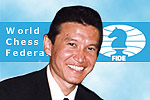| Handbook | C. General Rules and
Recommendations for Tournaments | 04.
FIDE Swiss Rules | 04.1.
Swiss System Based on Rating | D. Transposition and Exchange Procedures
D. Transposition and Exchange Procedures
| |
Example: S1 contains players 1, 2, 3 and 4 (in this sequence);
S2 contains players 5, 6, 7 and 8 (in this sequence). |
| D.1 |
Transpositions within S2 should start with the lowest players,
with descending priority:
- 5-6-8-7;
- 5-7-6-8;
- 5-7-8-6;
- 5-8-6-7;
- 5-8-7-6;
- 6-5-7-8;
- 6-5-8-7, etc.
Hint: put all numbers constructable with the digits 5, 6, 7 and
8 in ascending order. |
| D.2 |
When applying an exchange between S1 and S2 the difference
between the numbers exchanged should be as small as possible. When differences
of various options are equal take the one concerning the lowest player of
S1.
Exchange
one player
S1 |
|
Exchange
two players
S1 |
| |
4 |
3 |
2 |
S2 |
|
3+4 |
2+4 |
2+3 |
| 5 |
a |
c |
f |
5+6 |
j |
l |
o |
| 6 |
b |
e |
h |
5+7 |
k |
n |
q |
| 7 |
d |
g |
i |
6+7 |
m |
p |
r |
The above matrices contain the sequence in which exchanges
should be applied.
Exchanging one player: a) 4 and 5; b) 4 and 6; c) 3 and 5;
etc. until i) 2 and 7.
Exchanging two players: j) 3+4 with 5+6; k) 3+4 with
5+7; l) 2+4 with 5+6 etc. After each exchange both S1 and S2 should be ordered
according to A2.
Remark: if the number of players in a score bracket is odd,
S1 contains one player less than S2. So with 7 players S1 contains players 1, 2
and 3, S2 4, 5, 6 and 7. The exchanges needed in that case can be found from the
above ones by deducting all numbers in S1 and S2 by 1. The last column of the
second matrix has then become obsolete. | |
|


